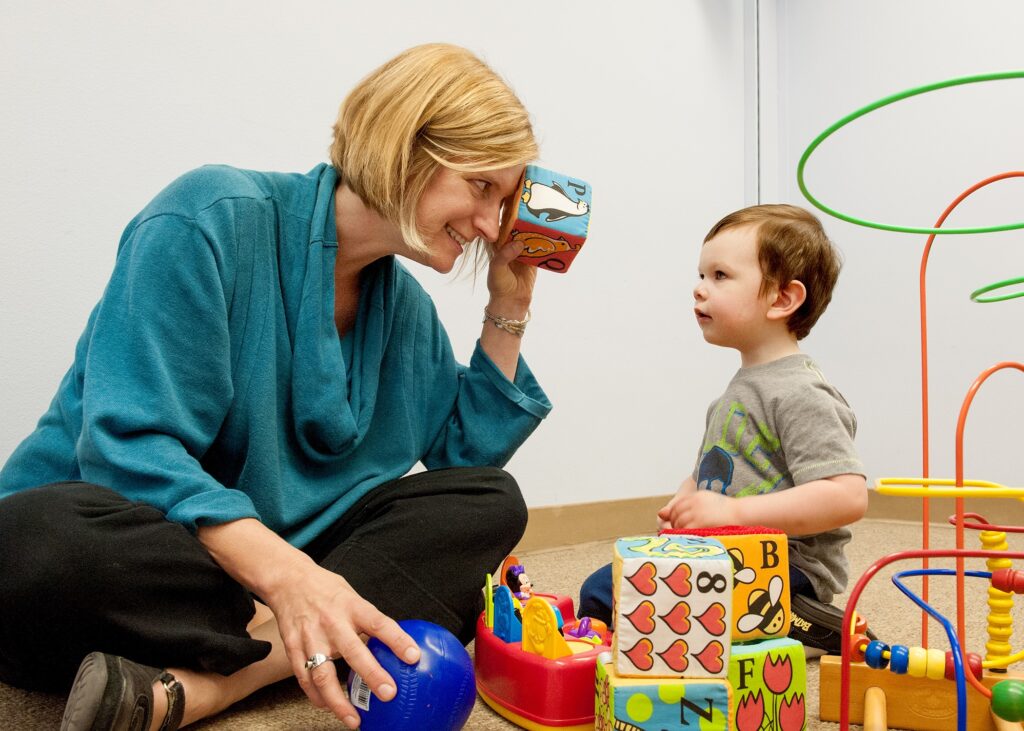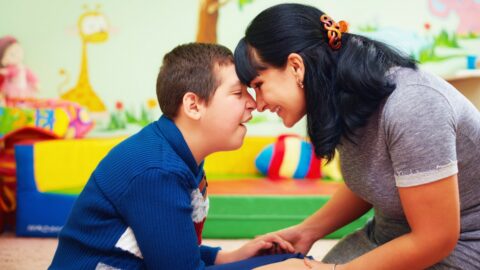What does autism mean?

If you are a parent who is concerned about whether or not your child might have autism, this article is for you. Autism is defined as a broad spectrum disorder that can include Asperger’s Syndrome, pervasive developmental disorders, and more. Symptoms of autism can range from mildly impaired social interaction and communication to extremely impaired or missing social interaction and communication. There is no one test that will prove whether or not a child has autism, but there are ways to find out if your child may have it. Autism symptoms can be detected through several different assessment tests that measure areas of language, socialization, and cognitive skills.
What causes autism?
Although the exact causes of Autism remain unknown, there is strong evidence linking a number of factors, such as immune system deficiencies, neurological disorders, brain development problems, nutritional deficiencies, exposure to toxic chemicals, and genetic syndromes. Researchers have determined that Autism is often caused by combinations of genes, neurological problems, environmental factors, and genetic syndromes. Additionally, the high level of anxiety that many sufferers exhibit likely contributes to the development of Autism. Researchers have yet to find a definitive cause for Autism, but they have traced some of the possible contributing factors and their findings are now being tested in hopes of uncovering the actual causes of Autism.
On the next page, we will share with you the causes autism. Be sure to check it out! And as always, if you have any concerns about autism or your child’s development in general, talk to his doctor.
Autism spectrum disorder symptoms :

The symptoms of autism vary from one patient to another, making it impossible to diagnose autism at a young age. As a result, many healthcare professionals will opt for diagnostic tests such as the CT scan or the MRI. These tests will help to identify if there are any abnormalities in the brain. Autism symptoms include poor relationships with peers, self-contentedness, extreme social awkwardness, and repetitive behaviors. These behaviors are typically not found in children with typical autism.
- Anxiety
The most common autistic behavior is anxiety. Anxiety can be triggered by many things; for example, getting into an argument at school or at home, or even just by looking around the room. Children with Asperger’s syndrome and autism often have a problem with processing information and expressing themselves socially.
- Obsession with sameness (repetitive behavior)
The second symptom of autism that we will cover here is the obsession with sameness. Children with autism have an obsession with sameness. This may mean that they repeat activities over again or constantly repeating the same phrase. Some children with autism use objects to signal what action needs to be performed.
Self-harm

The third symptom we will cover is self-harm. Children with autism are prone to inflicting physical harm on themselves. They will often pick at themselves, burn themselves with scalding water, poke themselves with needles, etc. These acts are indicative of obsessive-compulsive disorder and/or low self-esteem.
- Poor social interaction
People with ASDs often exhibit signs of a low level of social interaction and are often very self-centered. They also often lack eye contact, have a fixation for objects rather than people, and are normally very repetitive in their movements. They may have a tendency to be afraid of making eye contact, to repeat the same actions, or to repeat themselves. As a result, they often lack the ability to develop friendships and are usually very negative towards others.
How can you treat autism?

The treatment method that is chosen for the care of autistic individuals must be based on certain criteria. First, the patient must show signs of mild-to-moderate intellectual functioning. Secondly, the child must have a history of successful adaptation to a complex genetic syndrome. Lastly, the child must meet specific criteria for successful treatment according to the needs of the individual.
- Holding therapy
Holding therapy is an important component of treatment for autism spectrum disorder. This method aims to help improve the communication skills of the individual. Individuals with this condition often cannot speak or express themselves effectively. Holding therapy helps them to improve the communication abilities that they have. This is done by providing repetitive actions that are meaningful to the child.
The main goal of behavior interventions is to teach the child cognitive and communicative skills through applied behavioral analysis. The focus of applied behavior analysis is to teach the child positively, constructive behaviors. These behaviors help to alleviate certain behaviors that are negative to the individual, such as temper tantrums and self-injurious behavior. During the behavioral intervention, the patient will be given a number of behaviors to perform during each session. These behaviors can be modified with each child individually.
- Differential approach
Another autism treatment that is increasingly used is called the Differential Approach. This is a unique approach to autism treatment because it focuses on using many different approaches in one plan to attack the various symptoms of autism. By doing this, many people are able to discover unique strengths that their child has when coupled with certain behaviors. This then allows a plan to be put into place to increase these strengths and decrease the behaviors that their child exhibits. The greatest benefit to this method of treatment is that it leaves the child with a range of strengths and behaviors to work with rather than just one set of weaknesses.
Dietary interventions

Another autism treatment option is the dietary intervention approach. Many parents believe that autism symptoms can be strengthened by altering the diet of the patient. By doing so, a greater chance of developing a positive emotional disorder is present. This is due to the fact that one of the ways that a negative emotional disorder can develop is by having poor dietary choices. For this reason, a change in diet can prove to be a beneficial autism treatment option.
To conclude :
There is no definite cure for autism spectrum disorder. However, there are treatments available to alleviate symptoms of this lifelong condition. The symptoms of autism spectrum disorder can be treated successfully with therapy, medications, education, and various techniques. Most individuals with ASDs learn to control their symptoms and live happy, fulfilling lives.








tadalafil price
tadalafil price
how to order viagra
how to order viagra
sildenafil 20 mg online no prescription
sildenafil 20 mg online no prescription
viagra online uk paypal
viagra online uk paypal
sildenafil cost 100mg
sildenafil cost 100mg
can you buy generic viagra uk
can you buy generic viagra uk
tadalafil 40 mg with dapoxetine 60 mg
tadalafil 40 mg with dapoxetine 60 mg
cheapest cialis tadalafil 20 mg
cheapest cialis tadalafil 20 mg
cialis for enlarged prostate
cialis for enlarged prostate
tadalafil 20mg + dapoxetine 60mg
tadalafil 20mg + dapoxetine 60mg
can you use sulfamethoxazole-trimethoprim to treat bacterial vaginosis
can you use sulfamethoxazole-trimethoprim to treat bacterial vaginosis
neurontin gabapentin
neurontin gabapentin
metronidazole bg
metronidazole bg
valtrex packungsbeilage
valtrex packungsbeilage
tamoxifen keloids
tamoxifen keloids
does lyrica cause withdrawal symptoms
does lyrica cause withdrawal symptoms
furosemide duration
furosemide duration
lisinopril fibrosis
lisinopril fibrosis
metformin fiyat
metformin fiyat
rebellious diabetes pill
rebellious diabetes pill
semaglutide long term effects
semaglutide long term effects
keeping weight off after semaglutide
keeping weight off after semaglutide
how long does it take for zoloft to get out of your system
how long does it take for zoloft to get out of your system
gyno flagyl
gyno flagyl
cephalexin 500mg safe for pregnancy
cephalexin 500mg safe for pregnancy
can i drink on duloxetine
can i drink on duloxetine
lexapro blood pressure
lexapro blood pressure
viagra tablet cost in india
viagra tablet cost in india
is cipro and keflex the same
is cipro and keflex the same
cymbalta for neuropathic pain
cymbalta for neuropathic pain
gabapentin gastric
gabapentin gastric
trial of psilocybin versus escitalopram for depression
trial of psilocybin versus escitalopram for depression
what is fluoxetine 60 mg used for
what is fluoxetine 60 mg used for
ciprofloxacin dosage for dogs
ciprofloxacin dosage for dogs
can you open cephalexin capsules
can you open cephalexin capsules
bactrim for strep
bactrim for strep
bactrim price
bactrim price
amoxicillin and potassium clavulanate
amoxicillin and potassium clavulanate
flomax overdose side effects
flomax overdose side effects
diclofenac sodium side effects
diclofenac sodium side effects
ddavp length of action
ddavp length of action
how long does it take for citalopram to work
how long does it take for citalopram to work
effexor xr reviews
effexor xr reviews
can augmentin cause a yeast infection
can augmentin cause a yeast infection
ezetimibe children
ezetimibe children
blood pressure medicine cozaar
blood pressure medicine cozaar
flexeril mechanism of action
flexeril mechanism of action
naltrexone/bupropion (contrave) for weight loss
naltrexone/bupropion (contrave) for weight loss
how long does it take depakote to reach therapeutic levels
how long does it take depakote to reach therapeutic levels
diltiazem 60 mg
diltiazem 60 mg
amitriptyline para que sirve
amitriptyline para que sirve
aspirin nursing considerations
aspirin nursing considerations
allopurinol dosage during gout attack
allopurinol dosage during gout attack
aripiprazole tabs
aripiprazole tabs
celexa pregnancy
celexa pregnancy
celecoxib drug class
celecoxib drug class
is celebrex addictive
is celebrex addictive
can you snort baclofen 10 mg
can you snort baclofen 10 mg
when should you take ashwagandha
when should you take ashwagandha
alternative to semaglutide
alternative to semaglutide
acarbose pregnancy
acarbose pregnancy
remeron erowid
remeron erowid
robaxin dosage for muscle spasm
robaxin dosage for muscle spasm
repaglinide eg 1 мг
repaglinide eg 1 мг
abilify moa
abilify moa
actos medicos
actos medicos
protonix mechanism of action
protonix mechanism of action
janumet sitagliptin and metformin hcl
janumet sitagliptin and metformin hcl
ivermectin 0.5 lotion india
ivermectin 0.5 lotion india
tizanidine for migraine
tizanidine for migraine
voltaren diclofenac gel 2%
voltaren diclofenac gel 2%